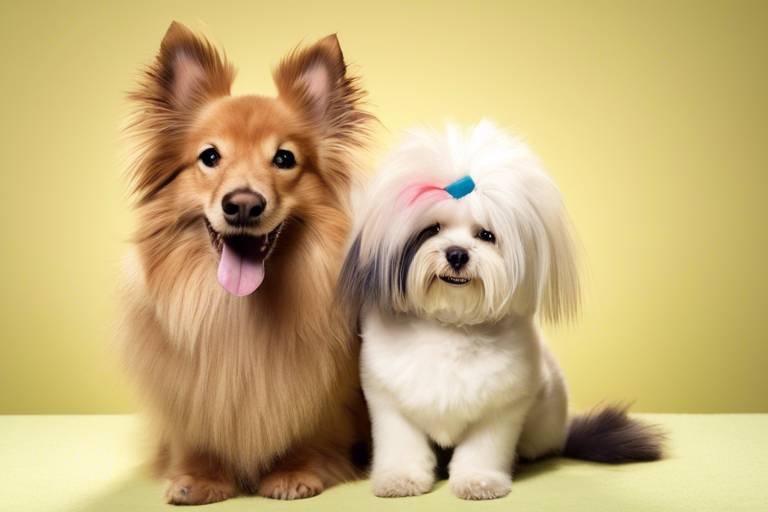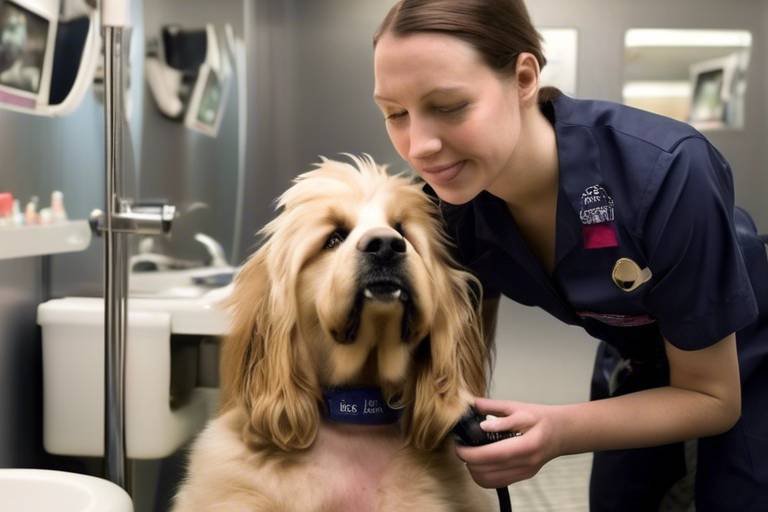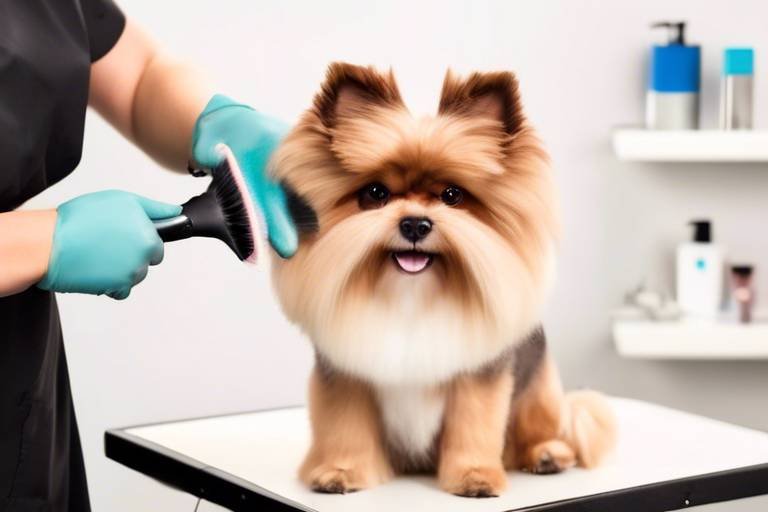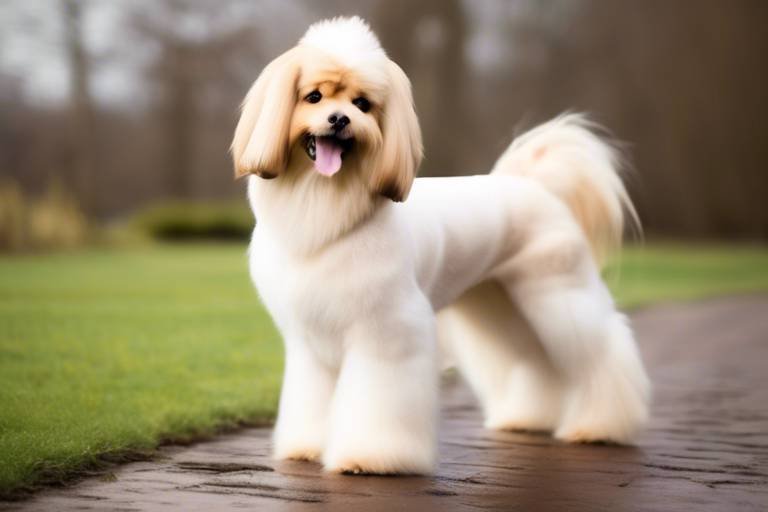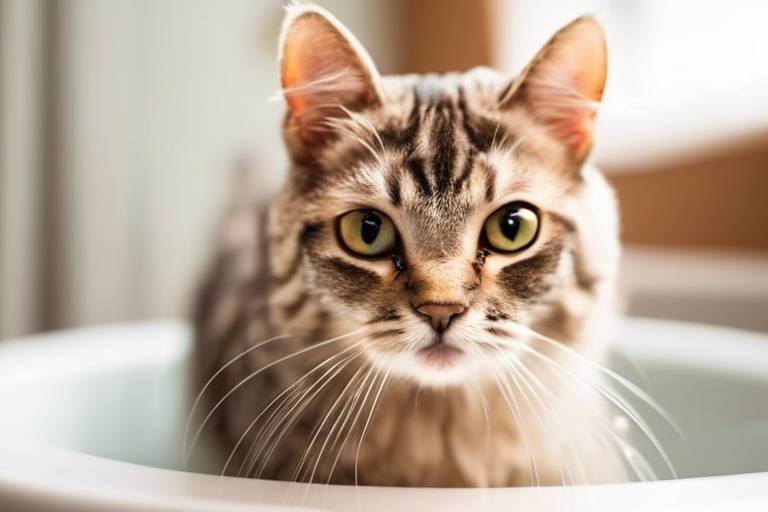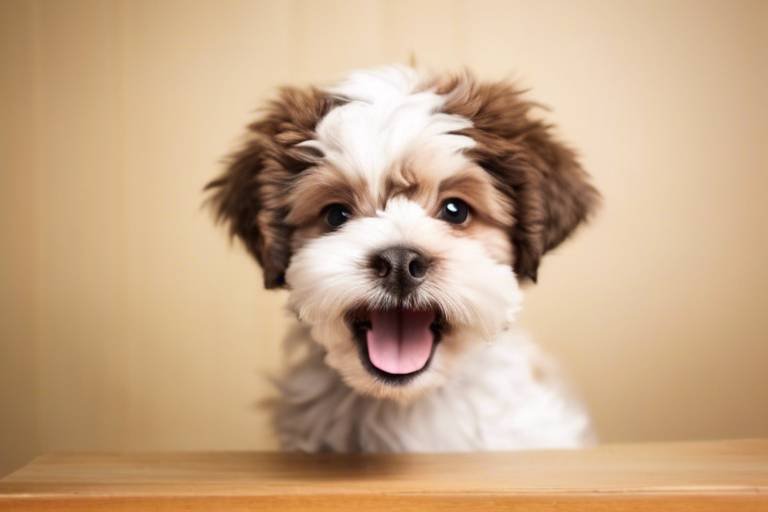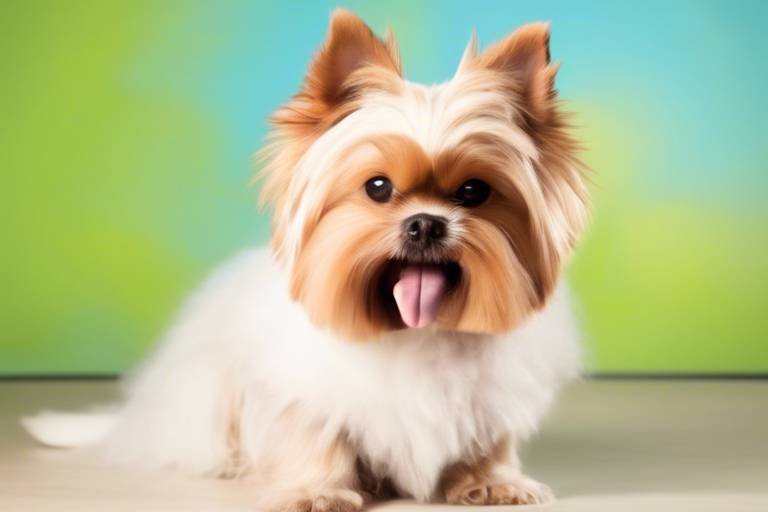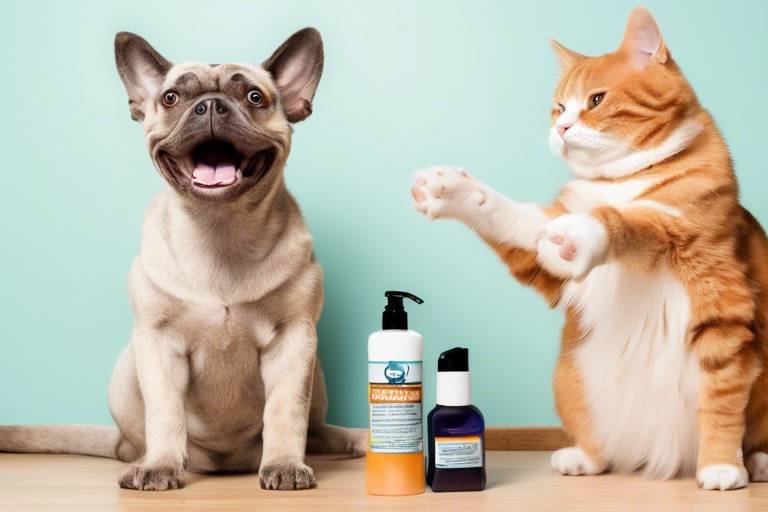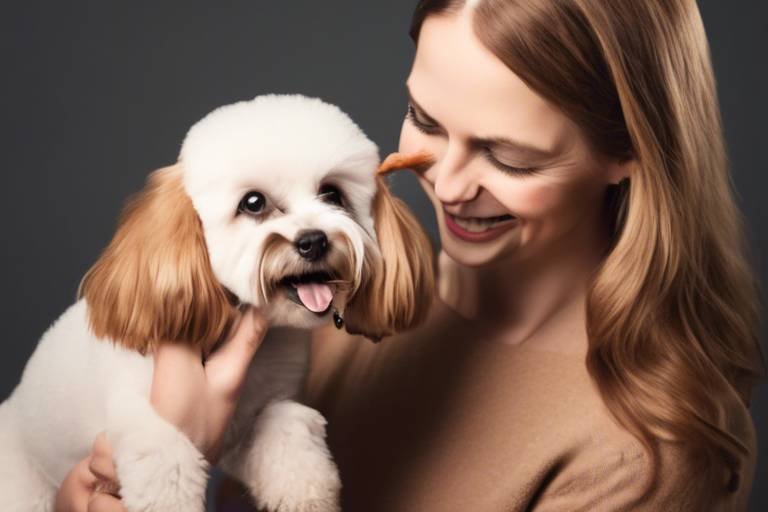Tips for Grooming Dogs with Different Temperaments
Grooming your dog is more than just a routine task; it's an opportunity to bond with your furry friend while ensuring they look and feel their best. However, not all dogs are the same, and their temperaments can greatly influence how they respond to grooming. Whether you have a nervous pup who shakes at the sight of clippers, an aggressive dog that requires extra caution, or a calm canine that enjoys the pampering, understanding these different temperaments is crucial for a successful grooming session.
In this article, we will dive deep into effective grooming techniques tailored to various dog personalities. By recognizing the unique needs of each temperament, you can create a grooming experience that is not only effective but also enjoyable for both you and your pet. Imagine grooming as a dance; when you know your partner's steps, you can move gracefully together. So, let’s explore how to adapt your grooming techniques to suit your dog's individual personality!
Recognizing the different temperaments of dogs is crucial for effective grooming. Dogs can be broadly classified into three main temperamental categories: nervous, aggressive, and calm. Each of these categories comes with its own set of personality traits that influence grooming behavior. For instance, nervous dogs may exhibit signs of anxiety, such as trembling or trying to escape, while aggressive dogs may show their discomfort through growling or snapping. On the other hand, calm dogs generally respond positively to grooming but still need a gentle touch and a consistent routine.
Understanding these traits not only helps in choosing the right grooming tools and techniques but also aids in creating a more comfortable and less stressful environment for your dog. Just like humans, dogs have their own comfort zones, and recognizing where those are can make all the difference. For example, if you know your dog is sensitive to loud noises, using quieter grooming tools can help ease their anxiety. In the next sections, we will explore specific grooming strategies tailored to each temperament, ensuring a stress-free experience for both the groomer and the pet.
Nervous dogs require a gentle and patient grooming approach to help them feel secure and calm. When grooming a nervous dog, it's essential to prioritize their comfort and well-being. Techniques such as environmental adjustments and the use of calming products can significantly ease the grooming process. For example, playing soft music or using pheromone sprays can create a soothing atmosphere that helps reduce anxiety.
A calming atmosphere can significantly impact a nervous dog's grooming experience. Consider the following tips for setting up a stress-free space:
- Choose a quiet area away from distractions.
- Use non-slip mats to provide stability and comfort.
- Ensure adequate lighting to avoid startling the dog.
By creating a serene environment, you set the stage for a more relaxed grooming session, making it easier for both you and your dog.
Positive reinforcement is an effective strategy for grooming nervous dogs. Using treats and praise during grooming can encourage desired behaviors and help reduce fear. For example, reward your dog with a small treat every time they allow you to brush a certain area. This approach not only builds trust but also makes grooming a more enjoyable experience for your furry friend.
Grooming aggressive dogs poses unique challenges that require specific techniques. Safety is paramount when dealing with aggressive dogs, and understanding their triggers can help prevent incidents. This section covers necessary precautions and effective strategies to manage aggression while ensuring a thorough grooming session.
Prioritizing safety is essential when grooming aggressive dogs. Here are some precautions to consider:
- Use a muzzle if necessary to prevent biting.
- Employ proper restraint techniques to keep the dog secure.
- Have a helper present if the dog is particularly difficult to handle.
By taking these precautions, you can protect both yourself and the dog, allowing for a safer grooming experience.
Desensitization can help reduce aggression during grooming. Gradual exposure methods can help dogs become more comfortable with grooming tools and processes over time. Start by introducing the grooming tools without immediate grooming, allowing the dog to sniff and explore them at their own pace. This gradual approach can significantly decrease fear and aggression, making future grooming sessions much easier.
Calm dogs typically make grooming easier, but they still require attention and care. While they may be more relaxed, it’s important to maintain their comfort throughout the process. Establishing a routine can greatly benefit calm dogs by reinforcing positive behavior and creating a sense of predictability.
A consistent grooming routine can enhance the experience for calm dogs. Regular grooming sessions not only keep their coat healthy but also help them understand that grooming is a normal part of life. Aim for a schedule that works for both you and your dog, and stick to it as much as possible. This predictability can make grooming feel like a fun and enjoyable activity rather than a chore.
Different grooming techniques can be applied to relaxed dogs. For instance, using gentle brushes and tools designed for sensitive skin can enhance their comfort. Regularly checking for mats and tangles is also important to maintain their coat's health. Remember, grooming should be a bonding experience, so take your time and enjoy the process!
- What should I do if my dog becomes aggressive during grooming? - Always prioritize safety. Use a muzzle if necessary, and consider consulting a professional groomer or trainer.
- How often should I groom my dog? - This depends on the breed and coat type. Generally, dogs should be groomed every 4-6 weeks.
- Can I use human grooming products on my dog? - No, human products can be harmful to dogs. Always use products specifically designed for pets.
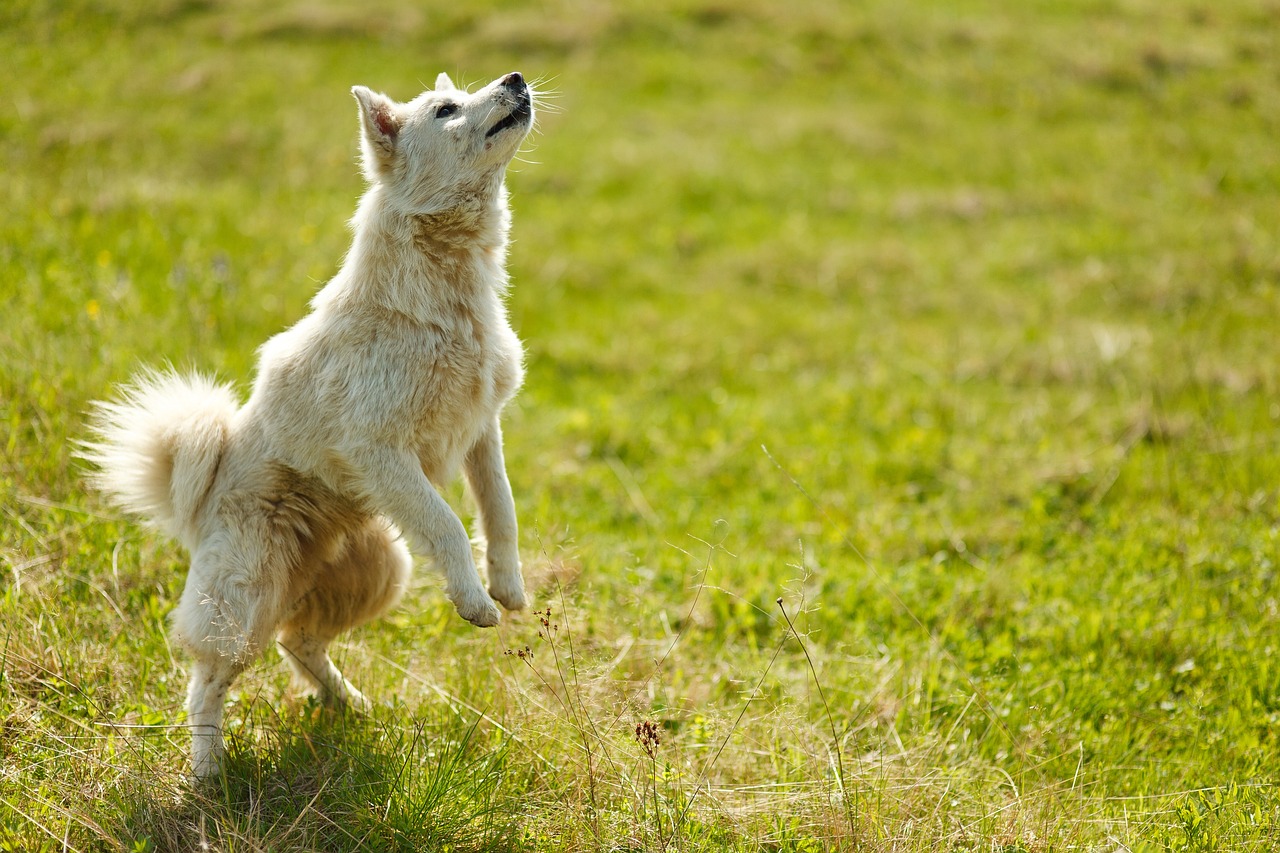
Understanding Dog Temperaments
When it comes to grooming our furry friends, understanding their temperament is absolutely essential. Just like humans, dogs have distinct personalities that can influence how they react to grooming. Some dogs are naturally calm and relaxed, while others may be more anxious or aggressive. By recognizing these traits, you can tailor your grooming approach to suit each dog's unique needs, making the experience smoother and more enjoyable for everyone involved.
Let’s dive a bit deeper into the key personality traits that influence grooming behavior:
- Nervous Dogs: These pups often feel uneasy or scared during grooming sessions. Their anxiety can stem from past experiences, unfamiliar tools, or even the sounds associated with grooming.
- Aggressive Dogs: Some dogs may show aggression when they feel threatened or uncomfortable. This behavior can manifest as growling, snapping, or attempting to escape.
- Calm Dogs: Generally, these dogs are more relaxed and comfortable with the grooming process. However, they still require attention and care to ensure a pleasant experience.
Understanding these temperamental differences is crucial because it allows you to adjust your grooming techniques accordingly. For instance, a nervous dog might benefit from a quiet, soothing environment and gentle handling, while an aggressive dog may require safety precautions and desensitization techniques to help them feel secure. By adapting your approach, you not only enhance the grooming experience but also strengthen the bond between you and your pet.
It’s also worth noting that a dog’s temperament can change over time. Factors such as age, health, and past experiences can all play a role in how a dog reacts to grooming. Therefore, it’s important to remain observant and flexible in your grooming strategies. Regularly assessing your dog’s comfort level during grooming can help you make adjustments as needed.
In summary, understanding dog temperaments is the first step toward effective grooming. By recognizing whether your dog is nervous, aggressive, or calm, you can create a grooming experience that is not only efficient but also enjoyable for both you and your furry companion.
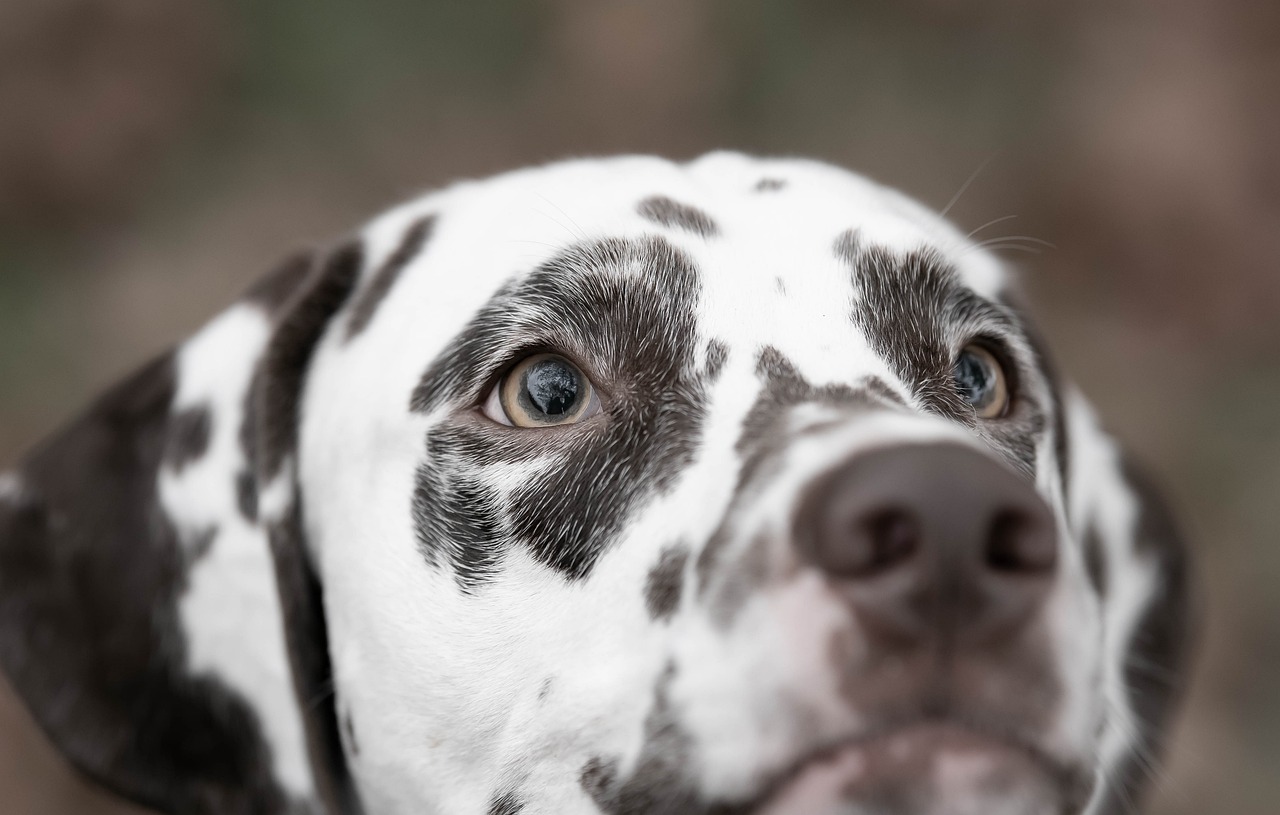
Grooming Nervous Dogs
Grooming a nervous dog can often feel like trying to solve a complex puzzle. These furry friends may tremble, whine, or even try to escape when confronted with grooming tools. It’s essential to approach the grooming process with a gentle hand and a calm demeanor. The goal is to create a positive experience that not only keeps your pup looking great but also builds their confidence over time.
One of the first steps in grooming nervous dogs is to understand their body language. A dog that is anxious may exhibit signs such as tucked tails, pinned ears, or avoidance behaviors. Recognizing these signals allows you to adjust your approach and make the grooming session as stress-free as possible. For instance, if your dog is showing signs of distress, take a break and give them some space. This will help them feel more secure and less overwhelmed.
To set the stage for a successful grooming session, it’s crucial to create a calm environment. Here are some strategies to consider:
- Choose a Quiet Space: Find a location that is free from loud noises and distractions. This could be a quiet room in your home or even outside in a peaceful area.
- Use Soothing Sounds: Soft music or white noise can help drown out sudden sounds that may startle your dog. Consider playing calming music specifically designed for pets.
- Comfortable Setup: Use a non-slip mat or blanket to create a comfortable grooming area. This will help your dog feel secure and less likely to slip or slide during the process.
Additionally, consider the temperature of the environment. A comfortable room temperature will help prevent your dog from becoming too hot or cold, which can increase their anxiety levels. Remember, a relaxed dog is a groomable dog!
Positive reinforcement is a game-changer when it comes to grooming nervous dogs. By rewarding your pup for calm behavior, you can help them associate grooming with positive experiences. Here’s how you can implement this technique:
- Start Small: Begin with short grooming sessions, gradually increasing the duration as your dog becomes more comfortable. This can help prevent overwhelming them.
- Offer Treats: Keep a stash of your dog’s favorite treats nearby. When they remain calm during grooming, offer a treat as a reward. This reinforces their good behavior.
- Give Praise: Use a cheerful tone to praise your dog throughout the grooming process. Simple phrases like “Good boy!” or “You’re doing great!” can boost their confidence.
By consistently applying positive reinforcement, you’ll not only make grooming a more enjoyable experience for your dog, but you’ll also help build trust between the two of you. Over time, your nervous pup will start to look forward to grooming sessions instead of dreading them.
In conclusion, grooming nervous dogs requires patience, understanding, and a bit of creativity. By creating a calm environment and utilizing positive reinforcement techniques, you can transform grooming from a stressful ordeal into a bonding experience that strengthens your relationship with your furry friend. Remember, the more relaxed and confident your dog feels, the easier the grooming process will be for both of you!
Q: How often should I groom my nervous dog?
A: The grooming frequency depends on your dog’s breed and coat type. Generally, aim for every 4 to 6 weeks, but adjust based on your dog’s comfort level.
Q: What if my dog bites during grooming?
A: If your dog shows aggression, it’s crucial to prioritize safety. Consider using a muzzle and consult a professional groomer or trainer for guidance.
Q: Are there calming products I can use?
A: Yes! There are various calming sprays, diffusers, and supplements available that can help soothe anxious dogs during grooming.
Creating a Calm Environment
When it comes to grooming nervous dogs, the environment plays a crucial role in ensuring a stress-free experience. Imagine walking into a room filled with loud noises and chaotic movements; it can be overwhelming, right? This is how a nervous dog feels when faced with an unsuitable grooming space. To create a calming atmosphere, start by choosing a quiet location, away from distractions and sudden noises. This will help your furry friend feel more secure and at ease.
Consider using soft, soothing music in the background. Studies have shown that calming music can reduce anxiety in dogs, making them more receptive to grooming. Additionally, ensure that the grooming area is well-lit but not overly bright, as harsh lighting can contribute to stress. You can also incorporate comfortable bedding or a favorite blanket to provide a sense of familiarity and safety for your dog.
Another essential aspect of creating a calm environment is the temperature of the room. Dogs can be sensitive to heat and cold, so make sure the space is at a comfortable temperature. You might also want to use a non-slip mat to provide stability during grooming, as this can help prevent slips and falls that might scare your dog.
Don't forget about the scents in the room! Using calming scents, such as lavender or chamomile, can help soothe a nervous dog. You can achieve this by using essential oil diffusers or scented candles, but be sure to choose pet-safe options. Additionally, having some treats on hand can create a positive association with the grooming environment, making your dog more likely to relax.
Lastly, consider the grooming tools you use. Opt for quiet clippers and brushes that are specifically designed for sensitive dogs. This can significantly reduce the fear associated with grooming. By implementing these strategies, you can transform the grooming experience into a soothing ritual that both you and your dog will look forward to.
- What should I do if my dog becomes anxious during grooming?
If your dog shows signs of anxiety, take a break and try to soothe them with gentle petting or calming words. You may also consider using calming products like sprays or supplements designed for dogs.
- How can I tell if my dog is stressed during grooming?
Signs of stress in dogs can include panting, pacing, whining, or trying to escape. If you notice these behaviors, it's essential to reassess your approach and create a more calming environment.
- Are there specific tools that help with grooming nervous dogs?
Yes! Look for tools that are designed for sensitive dogs, such as quiet clippers and gentle brushes. These tools can make a significant difference in reducing anxiety during grooming.
Using Positive Reinforcement
When it comes to grooming nervous dogs, positive reinforcement is not just a technique; it's a game changer. Imagine trying to convince a shy child to take a step into a crowded room. You wouldn’t just push them forward, right? You’d encourage them gently, perhaps with a favorite toy or a comforting word. The same principle applies to our furry friends. By using treats, praise, and affection, you can create a safe space that encourages your dog to be more receptive during grooming sessions.
One effective way to implement positive reinforcement is by associating grooming tools with something enjoyable. For instance, before you even pick up the brush, let your dog sniff it and give them a treat. This simple act can help them form a positive connection with the brush, making them less anxious when it’s time for grooming. It’s all about making the experience feel less like a chore and more like a fun bonding activity.
Additionally, timing is everything. When your dog shows calm behavior, even if it’s just for a moment, reward them immediately. This immediate reinforcement helps them understand that calmness during grooming leads to good things. You can also use a verbal cue, such as “good boy” or “well done,” in conjunction with treats to create a consistent message. Over time, your dog will begin to associate grooming with positive outcomes, which can significantly reduce their anxiety.
Here’s a quick breakdown of how to effectively use positive reinforcement during grooming:
- Start Slow: Introduce grooming tools gradually and reward your dog for exploring them.
- Use High-Value Treats: Offer treats that your dog loves, making them more eager to cooperate.
- Be Patient: If your dog becomes anxious, take a step back and give them time to relax before continuing.
- Celebrate Small Wins: Even small progress deserves a reward. If your dog allows you to brush a small section, celebrate that moment!
Remember, the goal is to make grooming a positive experience. With a little time and patience, you can turn what may seem like a daunting task into a fun and rewarding routine for both you and your dog. By focusing on positive reinforcement, you’re not just grooming; you’re building trust and strengthening your bond with your furry companion.
Q: How long should I groom my nervous dog?
A: Start with short sessions of about 5-10 minutes, gradually increasing the time as your dog becomes more comfortable.
Q: What if my dog refuses to be groomed?
A: It’s important to remain calm and patient. Take a break, try again later, or consult a professional groomer for advice.
Q: Can I use regular treats for positive reinforcement?
A: Yes, but high-value treats that your dog doesn’t get often can be more effective in encouraging good behavior during grooming.
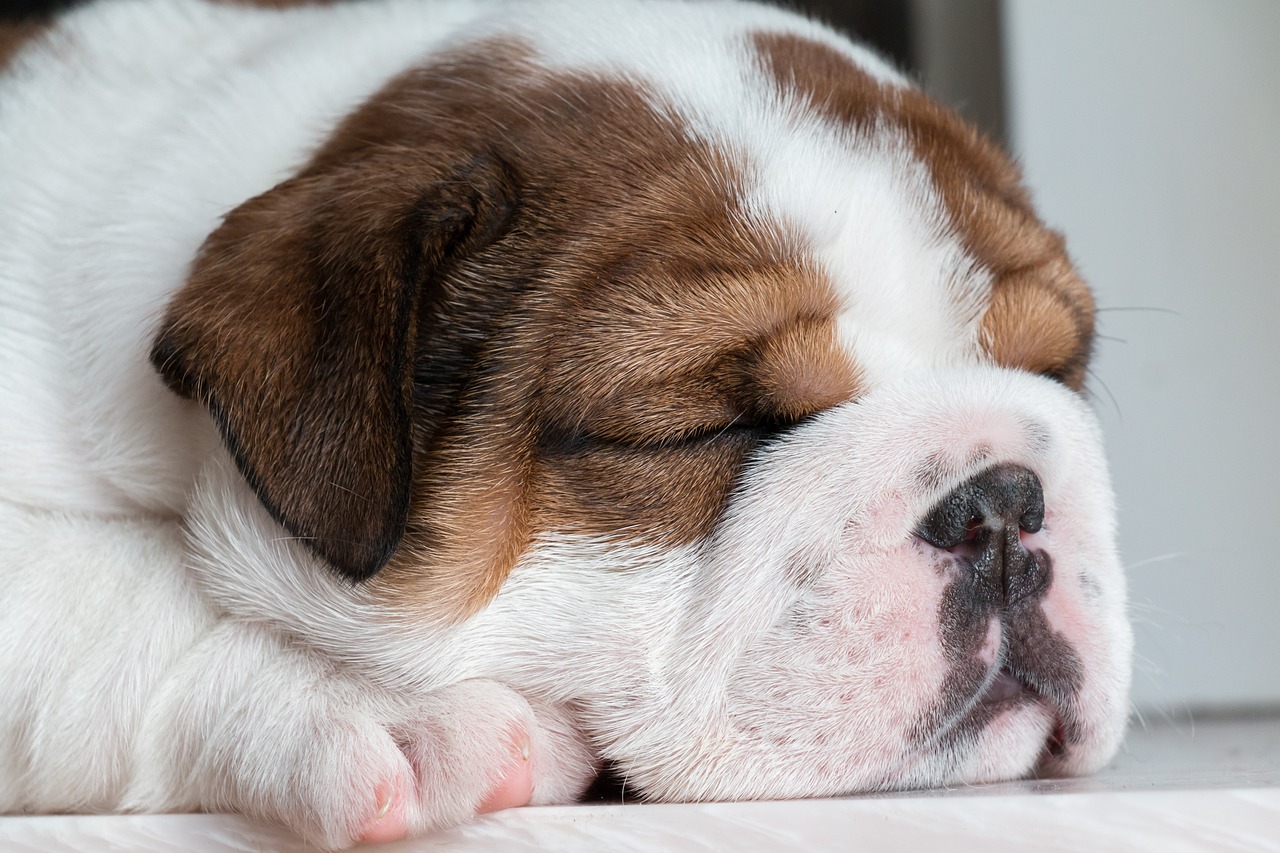
Handling Aggressive Dogs
Grooming aggressive dogs can be a daunting task, but with the right strategies and techniques, it can be done safely and effectively. Understanding that aggression often stems from fear or discomfort is the first step in addressing this behavior during grooming sessions. Preparation and awareness are key. Before you even think about bringing out the grooming tools, it’s essential to assess the dog's behavior. Are they growling, snapping, or showing signs of fear? Each of these behaviors requires a tailored response to ensure both the groomer and the dog remain safe.
One of the most important aspects of grooming aggressive dogs is implementing safety precautions. These precautions not only protect the groomer but also help in creating a more controlled environment for the dog. For instance, using a muzzle can be an effective way to prevent bites. However, it’s crucial to introduce the muzzle in a positive manner so that the dog associates it with something pleasant, like treats or praise. Additionally, proper restraint techniques, such as using a grooming table with a safety harness, can help keep the dog secure while minimizing the risk of injury.
Another effective strategy is to employ desensitization techniques. This involves gradually exposing the dog to the grooming tools and processes in a non-threatening way. Start by allowing the dog to sniff and explore the tools without any grooming taking place. This can help reduce their anxiety and build trust. Once the dog seems comfortable, you can slowly introduce the grooming process, beginning with less invasive tools, like a soft brush, before moving on to clippers or scissors. The goal is to create a positive association with grooming over time.
It’s also beneficial to have a plan in place for managing the grooming session. Consider the following steps to create a structured approach:
- Assess the Dog: Observe the dog's body language to gauge their comfort level.
- Set Up a Safe Space: Choose a quiet area free from distractions.
- Use Calming Aids: Products like pheromone sprays or calming music can help soothe the dog.
- Take Breaks: If the dog becomes agitated, take a break and allow them to relax.
Lastly, it's essential to remain calm and confident during the grooming process. Dogs can sense their owner's emotions, and projecting a calm demeanor can help reassure them. If at any point the dog becomes overly aggressive, it’s important to know when to stop and reassess the situation. Sometimes, it may be necessary to consult with a professional groomer or a dog trainer who specializes in aggressive behaviors. Remember, the goal is to create a safe and positive grooming experience for both you and your furry friend.
Here are some common questions regarding grooming aggressive dogs:
| Question | Answer |
|---|---|
| What should I do if my dog tries to bite during grooming? | Stop grooming immediately and assess the situation. Ensure the dog is secure and calm before trying again. |
| Can I groom my aggressive dog at home? | Yes, but it’s important to use the right techniques and safety measures. If you feel uncomfortable, consider hiring a professional. |
| How can I tell if my dog is aggressive or just scared? | Look for signs such as growling, barking, or snapping. Fearful dogs may also show signs of submission, like cowering. |
Safety Precautions
When it comes to grooming aggressive dogs, safety should always be your top priority. These dogs can be unpredictable, and a simple grooming session can quickly turn into a challenging situation if not handled properly. It's essential to be prepared and take necessary precautions to protect both yourself and the dog. One of the most important steps is to use a muzzle. Even if you believe the dog is generally friendly, a muzzle can prevent unexpected bites during grooming, especially when handling sensitive areas like the paws or face.
Moreover, proper restraint techniques are crucial. You might consider using a grooming table with a safety harness or a non-slip mat to keep the dog secure while you work. This not only helps in preventing sudden movements but also provides a sense of stability for the dog. Always approach the grooming process with a calm demeanor, as dogs can easily pick up on your anxiety. If you appear nervous or unsure, it may escalate their aggression.
In addition to muzzles and restraint, consider the following safety measures:
- Have a helper: If possible, enlist the help of another person to assist in holding the dog or distracting them during the grooming process.
- Use appropriate tools: Ensure that you are using grooming tools that are safe and appropriate for the dog's size and breed. Dull blades can cause discomfort and lead to more aggressive behavior.
- Know the dog's triggers: Understanding what causes the dog to react aggressively can help you avoid those situations. Whether it's certain sounds, tools, or even specific handling techniques, being aware of these triggers is key.
Finally, always have a first-aid kit on hand, just in case of any accidents. It’s better to be over-prepared than underprepared. Remember, grooming should be a positive experience, and taking these safety precautions can help ensure that both you and the dog have a successful and stress-free session.
Here are some common questions about grooming aggressive dogs and the safety precautions involved:
- How can I tell if my dog is aggressive? Look for signs such as growling, snapping, or showing teeth. Body language like stiff posture or raised hackles can also indicate discomfort.
- What should I do if my dog bites me during grooming? Remain calm and assess the situation. Clean the wound thoroughly and seek medical attention if necessary. Reflect on what may have triggered the aggression to avoid it in the future.
- Is it safe to groom an aggressive dog at home? If you are experienced and feel confident, it can be safe. However, if you are unsure, consider seeking professional help to avoid injury.
Desensitization Techniques
Desensitization techniques are crucial when it comes to grooming aggressive dogs. The goal here is to gradually introduce your furry friend to the grooming tools and processes, allowing them to become more comfortable over time. Imagine trying to teach a child to swim; you wouldn’t just throw them into the deep end! Instead, you’d start in the shallow end, letting them get used to the water. Similarly, desensitization involves taking small steps to build your dog's confidence and reduce their fear.
Start by familiarizing your dog with the grooming tools. Let them sniff and explore the equipment while rewarding them with treats and praise. You want to create a positive association with these tools. For example, if you're using clippers, turn them on in a separate room while giving your dog a tasty treat. This way, they learn that the sound of the clippers isn’t something to be afraid of. Gradually, bring the tools closer during subsequent sessions, always ensuring to reward your pup for calm behavior.
Another effective technique is to incorporate short grooming sessions into your routine. Begin with just a few minutes of brushing or handling their paws, then gradually increase the duration as your dog becomes more relaxed. This is akin to taking baby steps; the more comfortable they feel, the more they will trust you during grooming. You can also use a desensitization schedule to track your progress:
| Session | Duration | Activity | Dog's Reaction |
|---|---|---|---|
| 1 | 2 minutes | Letting them sniff the clippers | Curious |
| 2 | 3 minutes | Turning on the clippers | Relaxed with treats |
| 3 | 5 minutes | Brushing with a soft brush | Calm |
| 4 | 10 minutes | Full grooming session | Content |
Throughout this process, patience is key. If your dog shows signs of stress, take a step back and reduce the intensity of the session. You can also incorporate calming aids, such as pheromone sprays or calming music, to help create a soothing environment. Remember, every dog is different, and what works for one may not work for another. The ultimate goal is to transform grooming from a stressful event into a positive experience that both you and your dog can enjoy.
- How long does desensitization take? – The duration varies by dog; some may need only a few sessions, while others may take weeks.
- Can I use treats during the entire process? – Yes! Treats are a great way to reinforce positive behavior and build trust.
- What if my dog remains aggressive after desensitization? – Consult a professional trainer or behaviorist for additional strategies tailored to your dog's needs.

Grooming Calm Dogs
Grooming calm dogs can be a delightful experience, both for the pet and the groomer. These furry companions tend to be more relaxed, making the grooming process smoother and more enjoyable. However, it's essential to remember that even calm dogs need proper attention and care during grooming sessions. A well-structured approach not only enhances their comfort but also strengthens the bond between you and your pet.
Establishing a consistent grooming routine is crucial for calm dogs. Just like humans, dogs thrive on predictability. When they know what to expect, they are less likely to feel anxious or restless. A regular grooming schedule helps reinforce positive behavior and makes the process feel like a normal part of their day. Aim for a routine that works for both you and your dog, whether it’s weekly, bi-weekly, or monthly. The key is to stick to it!
When it comes to grooming techniques for relaxed dogs, there are several methods that can enhance the experience. For instance, using high-quality grooming tools can make a significant difference. Tools like slicker brushes, combs, and clippers designed for comfort can help maintain your dog's coat while ensuring their well-being. Here’s a quick breakdown of some recommended tools:
| Tool | Purpose |
|---|---|
| Slicker Brush | Removes loose hair and tangles |
| Combs | Detangles and smooths the coat |
| Clippers | Trims fur safely and efficiently |
| Scissors | For precise trimming around sensitive areas |
Additionally, incorporating a few grooming techniques can ensure that your calm dog remains comfortable and happy throughout the session. For example, always start by gently brushing your dog’s coat to remove any loose hair and dirt. This not only helps in keeping their coat shiny and healthy but also serves as a fantastic bonding activity. While grooming, pay attention to your dog's body language. If they seem relaxed, you can proceed with clipping or trimming, but if they show signs of discomfort, take a step back and reassure them.
Another important aspect is to maintain a calm demeanor yourself. Dogs are incredibly intuitive and can sense their owner's feelings. If you approach grooming with a relaxed attitude, your dog is likely to mirror that behavior. Use soothing tones when speaking to them, and don’t forget to offer plenty of praise and treats for good behavior. This positive reinforcement can make a world of difference and turn grooming into a fun and rewarding experience for both of you.
In conclusion, grooming calm dogs is about creating a comfortable environment, establishing a routine, and using the right tools and techniques. By paying attention to their needs and ensuring a stress-free experience, you can keep your calm canine looking and feeling their best. Always remember, grooming is not just a chore; it’s an opportunity to bond and show your furry friend how much you care.
- How often should I groom my calm dog? It depends on the breed and coat type, but generally, a routine every 4-6 weeks is ideal.
- What tools are best for grooming? A slicker brush, combs, clippers, and scissors are highly recommended for maintaining a healthy coat.
- Can I groom my dog at home? Absolutely! With the right tools and techniques, you can groom your dog comfortably at home.
- How can I make grooming more enjoyable for my dog? Use treats, praise, and maintain a calm environment to create a positive grooming experience.
Establishing a Routine
Establishing a grooming routine for calm dogs is not just beneficial; it’s essential for their overall well-being. Just like humans thrive on schedules, dogs find comfort in predictability. When you create a consistent grooming routine, you’re not only helping your dog look their best but also reinforcing positive behavior that can make grooming sessions smoother and more enjoyable. Imagine the peace of mind that comes with knowing your furry friend is ready for grooming without the fuss!
Consistency is key. Try to groom your dog at the same time each week or month, depending on their grooming needs. This way, your dog will start to associate grooming with a specific time, making them less anxious. For example, if you choose Saturday mornings, your dog will begin to anticipate the routine. The more familiar they become with the process, the less they will resist. Think of it as a dance; the more you practice, the better you both get at it!
In addition to timing, consider the grooming techniques you use. Different dogs may respond better to various methods. For instance, some dogs might enjoy a gentle brush while others prefer a more vigorous grooming session. It’s important to pay attention to your dog’s reactions and adjust your approach accordingly. You might even find that your dog enjoys certain tools more than others. Here’s a quick overview of common grooming tools:
| Tool | Best For |
|---|---|
| Brush | Removing loose fur and preventing mats |
| Comb | Smoothing out tangles and checking for fleas |
| Clippers | Trimming fur for a neat appearance |
| Scissors | Precision grooming around sensitive areas |
Lastly, don’t forget to incorporate a little fun into your routine! Grooming doesn’t have to be a chore; it can be a bonding experience. Play with your dog before and after grooming sessions, and reward them with treats or praise during the process. This positive reinforcement will help your dog to associate grooming with good things, making them more likely to cooperate in the future. Remember, a happy dog is a well-groomed dog!
- How often should I groom my dog? The frequency depends on the breed and type of coat. Generally, long-haired breeds require grooming at least once a week, while short-haired breeds can be groomed less frequently.
- What tools do I need for grooming? Basic grooming tools include a brush, comb, clippers, and scissors. The specific tools will depend on your dog's coat type.
- How can I make grooming less stressful for my dog? Establish a routine, use calming products, and provide positive reinforcement to help your dog feel more comfortable during grooming sessions.
- What should I do if my dog is aggressive during grooming? It’s important to prioritize safety. Consider consulting a professional groomer or trainer for guidance on managing aggressive behavior.
Grooming Techniques for Relaxed Dogs
Grooming relaxed dogs can be a delightful experience, both for the pet and the groomer. These dogs are typically more at ease with the grooming process, allowing for a smoother and more enjoyable session. However, it’s essential to maintain their comfort and well-being throughout the grooming experience. One of the key techniques is to use the right tools. For example, a high-quality brush can significantly enhance the grooming process by effectively removing loose fur without causing discomfort. A slicker brush, for instance, is perfect for dogs with thick or long coats, while a bristle brush works wonders for short-haired breeds.
Another important aspect of grooming relaxed dogs is to establish a consistent routine. Dogs thrive on predictability, and having a regular grooming schedule can help reinforce positive behaviors. Aim for a grooming session every four to six weeks, depending on the breed and coat type. This routine not only keeps their coat in top condition but also helps them associate grooming with positive experiences.
When it comes to bathing, relaxed dogs often enjoy the process, so make it a fun and engaging activity. Use lukewarm water and a gentle dog shampoo to ensure their comfort. During the bath, talk to your dog in a soothing voice and offer treats to create a positive association. After bathing, be sure to thoroughly dry their coat with a soft towel to prevent any chill, especially in cooler weather.
Additionally, consider incorporating a gentle massage into your grooming routine. This not only helps to relax the dog further but also allows you to check for any unusual lumps or skin issues. Massaging their coat can also help distribute natural oils, keeping their skin healthy and their coat shiny.
Finally, always remember to reward your dog after grooming sessions. This could be through treats, playtime, or simply some extra cuddles. Positive reinforcement will make your dog look forward to grooming time, ensuring that each session is a pleasant experience for both of you. By following these grooming techniques, you can maintain your relaxed dog's coat and health while deepening the bond you share.
- How often should I groom my relaxed dog?
It’s generally recommended to groom your dog every four to six weeks, but this can vary based on the breed and coat type. - What tools are best for grooming a relaxed dog?
High-quality brushes like slicker brushes for long-haired dogs and bristle brushes for short-haired breeds are ideal. - Can I give my dog a bath during grooming?
Absolutely! Bathing can be a fun part of the grooming process for relaxed dogs, just ensure to use lukewarm water and gentle shampoo. - How can I make grooming a positive experience?
Use treats, soothing voices, and gentle massages to create a comfortable environment and reward your dog after grooming.
Frequently Asked Questions
- What are the different dog temperaments I should be aware of when grooming?
Understanding dog temperaments is crucial for effective grooming. Dogs can be categorized into various temperaments, such as nervous, aggressive, and calm. Each temperament requires a tailored approach to ensure a positive grooming experience.
- How can I help a nervous dog during grooming?
To help a nervous dog, create a calm environment by minimizing noise and distractions. Additionally, using positive reinforcement, such as treats and praise, can encourage your dog and make the grooming process less stressful.
- What safety precautions should I take when grooming an aggressive dog?
When grooming aggressive dogs, safety is paramount. Use a muzzle if necessary and employ proper restraint techniques to protect both yourself and the dog. Always stay calm and confident to help ease the dog's anxiety.
- How can I desensitize my aggressive dog to grooming tools?
Desensitization involves gradually exposing your dog to grooming tools in a controlled manner. Start by allowing your dog to sniff the tools and reward them for calm behavior. Over time, increase the exposure until they are comfortable with the entire grooming process.
- What grooming techniques work best for calm dogs?
For calm dogs, establishing a consistent grooming routine is beneficial. Use gentle brushing techniques and appropriate grooming tools to maintain their coat while ensuring they remain comfortable and relaxed throughout the session.
- How often should I groom my dog?
The frequency of grooming depends on your dog's breed, coat type, and temperament. Generally, dogs should be groomed every 4 to 8 weeks, but some breeds may require more frequent grooming. Establish a routine that suits your dog's needs.




